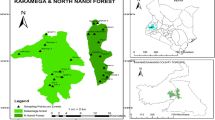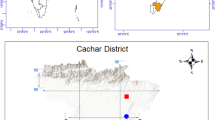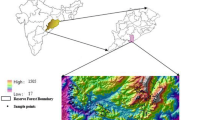Abstract
Studies on relationship between tree diversity and carbon stock has not been consistent. The present study was undertaken to quantify and compare the plant diversity and carbon stock in a subtropical broadleaved and a subtropical pine forest of Meghalaya, northeast India. Biomass-based carbon estimation was undertaken in two subtropical broadleaved forest stands viz., Mawnai (MBF) and Nongkrem (NBF) and adjacent Pinus kesiya dominated forest stands (MPF and NPF), occurring in similar topography, climatic conditions and soil type. The aboveground and belowground tree biomass was estimated using existing allometric models. Carbon was estimated as 47.4% of the total biomass. Tree species richness was greater in the subtropical broadleaved forest stands at MBF and NBF (117 and 21 species) than in the adjacent pine forests, MPF and NPF (15 and 16 species). The density values were 1294 and 1127 individuals ha−1 in the broadleaved forest stands, and 894 and 1032 individuals ha−1 in the adjacent pine forest stands, respectively. The broadleaved forest stands, MBF and NBF had tree biomass carbon stock of 140.4 Mg C ha−1 and 133.6 Mg C ha−1, respectively, which were significantly greater (F = 26.6; P < 0.05) than the pine forest stands, MPF and NPF (74.7 Mg C ha1 and 63 Mg C ha−1). The contribution of trees belonging to the higher DBH classes (> 66 cm) to the total biomass carbon was greatest in MBF, while the lower diameter trees belonging to 5–15 cm and 16–25 cm were the major contributors to the total biomass carbon in the pine dominated stands.





Similar content being viewed by others
References
Ali A, Yang E-R (2017) Relationships between biodiversity and carbon stocks in forest ecosystems: a systematic literature review. Trop Ecol 58(1):1–14
Ali A, Ma WJ, Yang XD, Sun BW, Shi QR, Xu MS (2014) Biomass and carbon stocks in Schima superba dominated subtropical forests of eastern China. J For Sci 60(5):198–207
Ayyappan N, Parthasarathy N (1999) Biodiversity inventory of trees in a large scale permanent plot of tropical evergreen forest at Varagaliar, Anamalais, Western Ghats, India. Biodivers Conserv 81:1513–1551
Baishya R, Barik SK (2011) Estimation of tree biomass, carbon pool and net primary production of an old-growth Pinus kesiya Royle ex. Gordon forest in north-eastern India. Ann For Sci 68:727–736
Baishya R, Barik SK, Upadhaya K (2009) Distribution pattern of aboveground biomass in natural and plantation forests of humid tropics in northeast India. Trop Ecol 50:295–304
Bellassen V, Luyssaert S (2014) Carbon sequestration: managing forests in uncertain times. Nature 506(7487):153–155
Borah N, Garkoti SC (2011) Tree species composition, diversity, and regeneration patterns in undisturbed and disturbed forests of Barak Valley, South Assam, India. Int J Ecol Environ Sci 37:131–141
Bosworth D, Birdsey R, Joyce L, Millar C (2008) Climate change and the nation’s forests: challenges and opportunities. J For 106:214–221
Cairns MA, Brown S, Helmer EH, Baumgardner GA (1997) Root biomass allocation in the world's upland forests. Oecologia 111:1–11
Campbell DG, Stone JL, Rosas A Jr (1992) A comparison of the phytosociology and dynamics of three flood plain (Varzae) forests of known ages, Rio Jurua, Western Brazilian Amazon. Bot J Linn Soc 108:213–237
Chambers JQ, dos Santos J, Ribeiro RJ, Higuchi N (2001) Tree damage, allometric relationships and aboveground net primary production in central Amazon forest. For Ecol Manag 152:73–84
Chaudhary G, Upadhaya K (2016) Biomass and carbon stock in subtropical broad-leaved forest ecosystem of Meghalaya, Northeast India. Int J Ecol Environ Sci 42(2):125–133
Con VT, Thang TN, Thanh-Ha TD, Khiem CC, Quy HT, Lam TV, Do VT, Sato T (2013) Relationship between aboveground biomass and measures of structure and species diversity in tropical forests of Vietnam. For Ecol Manage 310:213–218
Curtis JT, McIntosh RP (1950) The interrelations of certain analytic and synthetic phytosociological characters. Ecology 31(3):434–455
Dixon RK, Solomon AM, Brown S, Houghton RA, Trexier MC, Wisniewski J (1994) Carbon pools and flux of global forest ecosystems. Science 263:185–190
Drever RC, Peterson G, Messier C, Bergeron Y, Flannigan M (2006) Can forest management based on natural disturbances maintain ecosystem resilience? Can J For Res 36:2285–2299
Firn J, Erskine PD, Lamb D (2007) Woody species diversity influences productivity and soil nutrient availability in tropical plantations. Oecologia 154:521–533
Gardner TA, Burgess ND, Aquilar-Amuchastegui N, Barlow J, Berenguer E, Clements T, Danielsen F, Ferreira J, Foden W, Kapos V, Khan SM, Lees AC, Parry L, Roman-Cuesta RM, Schmitt CB, Strange N, Theilade I, Vieira ICG (2012) A framework for integrating biodiversity concerns into national REDD programmes. Biol Conserv 154:61–71
Haridasan K, Rao RR (1985–1987) Forest flora of Meghalaya, vol 2. Bishen Singh Mahendrapal Singh, Dehradun
He Y, Qin L, Li Z, Liang X, Shao M, Tan L (2013) Carbon storage capacity of monoculture and mixed-species plantations in subtropical China. For Ecol Manage 295:193–198
Holling CS (1973) Resilience and stability of ecological systems. Annu Rev Ecol Syst 4:1–23
Hu Y, Su Z, Li W, Ke X (2015) Influence of tree species composition and community structure on carbon density in a subtropical forest. PLoS ONE 10(8):e0136984
Huy B, Anh TA (2008) Estimating CO2 sequestration in natural broad-leaved evergreen forest in Vietnam. Asia-Pac Agrofor News (FAO) 32:7–10
Johnston MA, Gillman MP (1995) Tree population studies in low-diversity forests, Guyana. I. Floristic composition and stand structure. Biodivers Conserv 4:339–362
Joshi RK, Dhyani S (2019) Biomass, carbon density and diversity of tree species in tropical dry deciduous forests in Central India. Acta Ecol Sin 39(4):289–299
Kadavul K, Parthasarathy N (1999) Plant biodiversity and conservation of tropical semi-evergreen forest in the Shervarayan hills of Eastern Ghats, India. Biodivers Conserv 8:421–439
Kanjilal VN, Kanjilal PC, Das A, De RN and Bor NL (1934–1940) Flora of Assam, vol 5. Government Press, Shillong.
Kirby KR, Potvin C (2007) Variation in carbon storage among tree species: implications for the management of a small-scale carbon sink project. For Ecol Manage 246:208–221
Le-Quéré C, Andrew RM, Friedlingstein P, Sitch S, Hauck J, Pongratz J, Pickers PA, Korsbakken JI, Peters GP, Canadell JG, Arneth A, Arora VK, Barbero L, Bastos A, Bopp L, Chevallier F, Chini LP, Ciais P, Doney SC, Gkritzalis T, Goll DS, Harris I, Haverd V, Hoffman FM, Hoppema M, Houghton RA, Hurtt G, Ilyina T, Jain AK, Johannessen T, Jones CD, Kato E, Keeling RF, Goldewijk KK, Landschützer P, Lefèvre N, Lienert S, Liu Z, Lombardozzi D, Metzl N, Munro DR, Nabel JEMS, Nakaoka S-I, Neill C, Olsen A, Ono T, Patra P, Peregon A, Peters W, Peylin P, Pfeil B, Pierrot D, Poulter B, Rehder G, Resplandy L, Robertson E, Rocher M, Rödenbeck C, Schuster U, Schwinger J, Séférian R, Skjelvan I, Steinhoff T, Sutton A, Tans PP, Tian H, Tilbrook B, Tubiello FN, van der Laan-Luijkx IT, van der Werf GR, Viovy N, Walker AP, Wiltshire AJ, Wright R, Zaehle S, Zheng B (2018) Global carbon budget 2018. Earth Syst Sci Data 10:2141–2194
Lei X, Wang W, Peng C (2009) Relationships between stand growth and structural diversity in spruce-dominated forests in New Brunswick, Canada. Can J For Res 39:1835–2184
Li Y, Bao W, Bongers F, Chen B, Chen G, Guo K, Jiang M, Lai J, Lin D, Liu C, Liu X, Liu Y, Mi X, Tian X, Wang X, Xu W, Yan J, Yang B, Zheng Y, Ma K (2019) Drivers of tree carbon storage in subtropical forests. Sci Total Environ 654:684–693
Liang J, Buongiorno J, Monserud RA, Kruger EL, Zhou M (2007) Effects of diversity of tree species and size on forest basal area growth, recruitment, and mortality. For Ecol Manage 243:116–127
Lin D, Jiangshan L, Muller-Landau HC, Mi X, Ma K (2012) Topographic variation in aboveground biomass in a subtropical evergreen broad-leaved forest in China. PLoS ONE 7(10):e48244
Martin AR, Thomas SC (2011) A reassessment of carbon content in tropical trees. PLoS ONE 6:e23533
Midgley GF, Bond WJ, Kapos VK, Ravilious C, Scharlemann JPW, Woodward FI (2010) Terrestrial carbon stocks and biodiversity: key knowledge gaps and some policy implications. Curr Opin Environ Sustain 2:264–270
Mittelbach GG, Steiner CF, Scheiner SM, Gross KL, Reynolds HL, Waide RB, Willig MR, Dodson SI, Gough L (2001) What is the observed relationship between species richness and productivity? Ecology 82:2381–2396
Pan Y, Birdsey RA, Fang J, Houghton R, Kauppi PE, Kurz WA, Philips OL, Schivdenko A, Lewis SL, Canadell JG, Ciasis P, Jackson RB, Pacala SW, McGuire AD, Piao S, Rautiainen A, Sitch S, Hayes D (2011) A large and persistent carbon sink in the world’s forests. Science 333:988–993
Parthasarathy N (1999) Changes in tropical forest composition and structure in three sites of tropical wet evergreen forest around Sengaltheri, Western Ghats. Curr Sci 80:389–393
Parthasarathy N, Mani S (2007) Aboveground biomass estimation in ten tropical dry evergreen forest sites of peninsular India. Biomass Bioenergy 31(5):284–290
Parthasarathy N, Kinhal V and Praveenkumar L (1992) Plant species diversity and human impacts in the tropical wet evergreen forests of south Western Ghats. In: Indo-French Workshop on Tropical Forest Ecosystems: Natural Functioning and Anthropogenic Impact, pp 26–27. French Institute, Pondicherry.
Ramachandran A, Jayakumar S, Haroon RM, Bhaskaran A, Arockiasamy DI (2007) Carbon sequestration: estimation of carbon stock in natural forests using geospatial technology in the Eastern Ghats of Tamil Nadu, India. Curr Sci 92:323–331
Rao P, Barik SK, Pandey HN, Tripathi RS (1990) Community composition and tree population structure in a sub-tropical broad-leaved forest along a disturbance gradient. Vegetatio 88(2):151–162
Salunkhe O, Khare PK, Sahu TR, Singh S (2016) Estimation of tree biomass reserves in tropical deciduous forests of Central India by non-destructive approach. Trop Ecol 57(2):153–161
Shannon CE, Weaver W (1963) The mathematical theory of communication. University of Illinois Press, Urbana
Simpson EH (1949) Measurement of diversity. Nature 163:688
Singh A, Reddy VS, Singh JS (1995) Analysis of woody vegetation of Corbett National Park, India. Vegetatio 120:69–79
Strassburg BBN, Kelly A, Balmford A, Davies RG, Gibbs HK, Lovett A, Miles L, David C, Orme L, Price J, Turner KR, Rodrigues ASL (2009) Global congruence of carbon storage and biodiversity in terrestrial ecosystems. Conserv Lett 3:98–105
Terakunpisut J, Gajaseni N, Ruankawe N (2007) Carbon sequestration potential in aboveground biomass of Thong phaphun national forest, Thailand. Appl Ecol Environ Res 5:93–102
Thompson I, Mackey B, McNulty S, Mosseler A (2009) Forest resilience, biodiversity and climate change. A synthesis of the biodiversity/resilience stability relationship in forest ecosystems. Tech Ser 43:1–67
Upadhaya K, Pandey HN, Law PS, Tripathi RS (2004) Diversity and population characteristics of woody species in subtropical humid forest exposed to cultural disturbance in Meghalaya, Northeast India. Trop Ecol 45(2):303–314
Vilà M, Vayreda J, Gracia C, Ibáñez JJ (2003) Does tree diversity increase wood production in pine forests? Oecologia 135:299–303
World Conservation Monitoring Centre (WCMC) (1992) Global biodiversity: status of the earths living resources. Chapman & Hall, London
Yuan ZW, Shaopeng A, Ali A, Gazol P, Ruiz-Benito X, Wang F, Lin J, Ye ZH, Loreau M (2018) Aboveground carbon storage is driven by functional trait composition and stand structural attributes rather than biodiversity in temperate mixed forests recovering from disturbances. Ann For Sci 75:67
Zhang J, Ge Y, Jiang B, Jiang H, Peng C, Zhu J, Yuan W, Qi L, Yu S (2007) Carbon storage by ecological service forests in Zhejiang Province, subtropical China. For Ecol Manage 245(1–3):64–75
Acknowledgements
The financial support from the Ministry of Environment, Forest & Climate Change under the All India Coordinated Project on Sacred Grove Ecosystem Services Assessment in Meghalaya is gratefully acknowledged.
Author information
Authors and Affiliations
Corresponding author
Rights and permissions
About this article
Cite this article
Gogoi, R.R., Adhikari, D., Upadhaya, K. et al. Tree diversity and carbon stock in a subtropical broadleaved forest are greater than a subtropical pine forest occurring in similar elevation of Meghalaya, north-eastern India. Trop Ecol 61, 142–149 (2020). https://doi.org/10.1007/s42965-020-00061-1
Received:
Revised:
Accepted:
Published:
Issue Date:
DOI: https://doi.org/10.1007/s42965-020-00061-1




